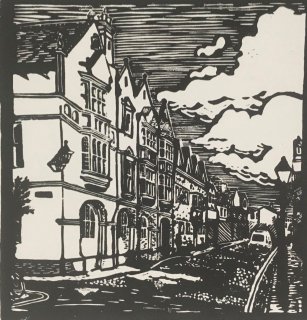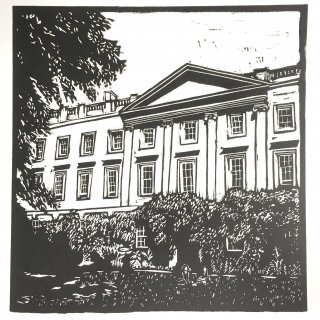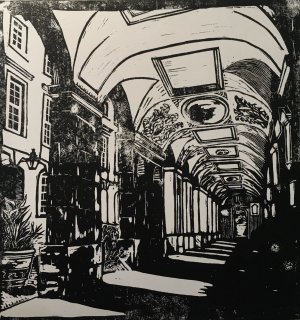Intro
We have 30 sets of four linocuts remaining.
Tara describes her creative process in an article she wrote for the July issue of the Sundial Magazine.
In the footsteps of William Blake
“But first the notion that man has a body distinct from his soul, is to be expunged; this I shall do, by printing in the infernal method, by corrosives, which in Hell are salutary and medicinal, melting apparent surfaces away, and displaying the infinite which was hid.” William Blake, The Marriage of Heaven and Hell
From cobble stones to roof tiles, from the leaves of a bamboo plant to the gleam on a golden pelican, it has been immensely satisfying for me to work to reproduce the beautiful details that can be found around the college I have the privilege to call home. I usually begin with a fresh piece of linoleum, smooth as tarmac, and flexible enough that my engraving tool will cut into it without much pressure. I have a vision of what this piece of pale grey material could become, knowing that the material will have a say in the process as well.
With fineliner pen in hand, I sketch the outlines of my design, remembering to work in reverse, before laying down areas of shadow with washes of watered-down ink. Once I am happy with my loose plan, I am ready to begin carving, starting on the largest areas of white before attempting the finer detail. The work is always improvisational. I think of it as sculpting in light. Each cut, bold or delicate, precise or impressionistic, marks where light reflects off a surface. Every cut is a decision made in the moment. There is little room for error, but plenty of room for discovery. Eventually the image emerges. I make several proofs, making small adjustments after each, before the piece is deemed done.
It’s a delicious process, carving out pieces and slivers of light. In doing so I have sought to live out a certain artistic ideal, one in which concept and execution are involved in a curious feedback loop as the work unfolds moment by moment before my eyes.
William Blake was my introduction to printmaking. Writing on his etching techniques in my Master’s thesis, I found myself aching to experience the artform at first-hand. Blake considered it the printmaker’s task to reveal the visionary image which was hidden beneath the placid surface of the metal plate. However, his actual work
was the vibrant product of spontaneity. According to the scholar
Joseph Viscomi, instead of meticulously tracing a text and design which had been worked out in advance, Blake usually created the work directly on the plate based on loose preliminary drafts. Invention and execution were closely coupled in Blake’s work as creative thinking occurred on the copper plate.
For me, linocut printing has indeed proven itself salutary, medicinal, in a time when many working environments, especially in the academic world, emphasise cerebral premeditation at the expense of intuitive experience, intimately and corporeally lived.



